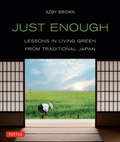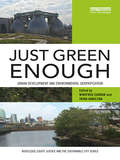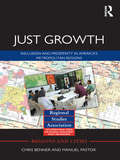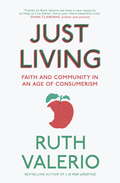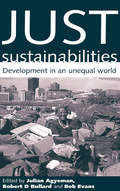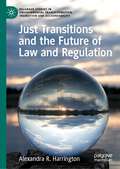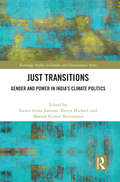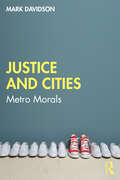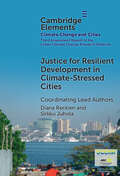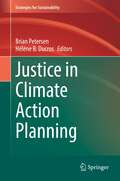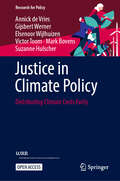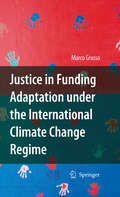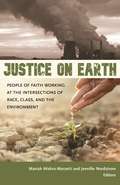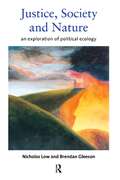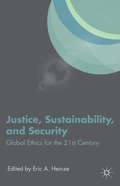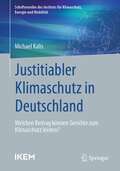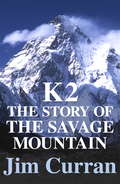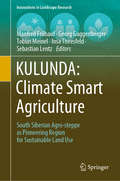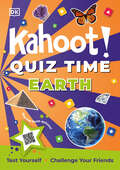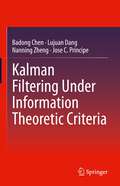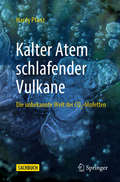- Table View
- List View
Just Enough
by Azby BrownThe world has changed immeasurably over the last thirty years, with more, bigger, better being the common mantra. But in the midst of this constantly evolving world, there is a growing community of people who are looking at our history, searching for answers to issues that are faced everywhere, such as energy, water, materials, food and population crisis.In Just Enough, author Azby Brown turned to the history of Japan, where he finds a number of lessons on living in a sustainable society that translate beyond place and time. This book of stories depicts vanished ways of life from the point of view of a contemporary observer, and presents a compelling argument around how to forge a society that is conservation-minded, waste-free, well-housed, well-fed and economically robust.Included at the end of each section are lessons in which Brown elaborates on what Edo Period life has to offer us in the global battle to reverse environmental degradation. Covering topics on everything from transportation, interconnected systems, and waste reduction to the need for spiritual centers in the home, there is something here for everyone looking to make changes in their life.Just Enough is much-needed beacon in our evolving world, giving us hope in our efforts to achieve sustainability now.
Just Green Enough: Urban Development and Environmental Gentrification (Routledge Equity, Justice and the Sustainable City series)
by Winifred Curran Trina HamiltonWhile global urban development increasingly takes on the mantle of sustainability and "green urbanism," both the ecological and equity impacts of these developments are often overlooked. One result is what has been called environmental gentrification, a process in which environmental improvements lead to increased property values and the displacement of long-term residents. The specter of environmental gentrification is now at the forefront of urban debates about how to accomplish environmental improvements without massive displacement. In this context, the editors of this volume identified a strategy called "just green enough" based on field work in Greenpoint, Brooklyn, that uncouples environmental cleanup from high-end residential and commercial development. A "just green enough" strategy focuses explicitly on social justice and environmental goals as defined by local communities, those people who have been most negatively affected by environmental disamenities, with the goal of keeping them in place to enjoy any environmental improvements. It is not about short-changing communities, but about challenging the veneer of green that accompanies many projects with questionable ecological and social justice impacts, and looking for alternative, sometimes surprising, forms of greening such as creating green spaces and ecological regeneration within protected industrial zones. Just Green Enough is a theoretically rigorous, practical, global, and accessible volume exploring, through varied case studies, the complexities of environmental improvement in an era of gentrification as global urban policy. It is ideal for use as a textbook at both undergraduate and graduate levels in urban planning, urban studies, urban geography, and sustainability programs.
Just Growth: Inclusion and Prosperity in America's Metropolitan Regions (Regions and Cities)
by Chris Benner Manuel PastorBreaking new ground in its innovative blend of quantitative and qualitative methods, the book essentially argues that another sort of growth is indeed possible. While offering specific insights for regional leaders and analysts of metropolitan areas, the authors also draw a broader – and quite timely – set of conclusions about how to scale up these efforts to address a U.S. economy still seeking to recover from economic crisis and ameliorate distributional divisions.
Just Living: Faith and Community in an Age of Consumerism
by Ruth ValerioGlobalisation and consumerism affect every area of our lives. But it's not just about shopping; these powerful forces shape our personal lives, how we relate to one another, how we view the world - and they are having a seriously detrimental impact both on the lives of the global poor, and on the health of the planet itself.Every Christian in every generation down through the history of the church has had to work out what it means to be a follower of Jesus in their particular culture; for us in the twenty-first century, we must think about discipleship in a globalised, consumerist context. Environmentalist and theologian Ruth Valerio examines these issues in a book that is intellectually rigorous yet practical, and as inspiring as it is challenging.
Just Living: Faith and Community in an Age of Consumerism
by Ruth ValerioGlobalisation and consumerism affect every area of our lives. But it's not just about shopping; these powerful forces shape our personal lives, how we relate to one another, how we view the world - and they are having a seriously detrimental impact both on the lives of the global poor, and on the health of the planet itself.Every Christian in every generation down through the history of the church has had to work out what it means to be a follower of Jesus in their particular culture; for us in the twenty-first century, we must think about discipleship in a globalised, consumerist context. Environmentalist and theologian Ruth Valerio examines these issues in a book that is intellectually rigorous yet practical, and as inspiring as it is challenging.
Just Sustainabilities: Development in an Unequal World (Urban And Industrial Environments Ser.)
by Bob Evans Robert D. Bullard Julian AgyemanEnvironmental activists and academics alike are realizing that a sustainable society must be a just one. Environmental degradation is almost always linked to questions of human equality and quality of life. Throughout the world, those segments of the population that have the least political power and are the most marginalized are selectively victimized by environmental crises. This book argues that social and environmental justice within and between nations should be an integral part of the policies and agreements that promote sustainable development. The book addresses the links between environmental quality and human equality and between sustainability and environmental justice.
Just Transitions and the Future of Law and Regulation (Palgrave Studies in Environmental Transformation, Transition and Accountability)
by Alexandra R. HarringtonThis book provides a comprehensive assessment of how national and international efforts to achieve carbon neutrality have been embraced as necessary to meet the requirements of the Paris Agreement as well as the needs of the planet. The authors explore the increasing tensions between aspirations and entrenched practices as methods to implement carbon neutrality are devised, particularly at the national and sub-national levels. This is perhaps best typified by efforts to shift from “dirty” energy production, such as coal, to greener alternatives, which are often supported in laws and rules but opposed by society. To bridge this void, the concept of just transitions has increasingly come to the forefront of international and national focus yet is often poorly understood. This book examines the ways in which just transitions have been proposed as a legal and regulatory bridge to address issues that result in societal resistance to implementation. It uses past and existing practice studies of just transitions before providing an analysis of how just transitions can be used to not only to assist in the shift to carbon neutrality but also in new shifts such as those caused by the Covid-19 pandemic impacts on economy, environment and society, and to address future global challenges.
Just Transitions: Gender and Power in India’s Climate Politics (Routledge Studies in Gender and Environments)
by Seema Arora-Jonsson Kavya Michael Manish Kumar ShrivastavaThis book turns critical feminist scrutiny on national climate policies in India and examines what transition might really mean for marginalized groups in the country. A vision of “just transitions” is increasingly being used by activists and groups to ensure that pathways towards sustainable futures are equitable and inclusive. Exploring this concept, this volume provides a feminist study of what it would take to ensure just transitions in India where gender, in relation to its interesting dimensions of power, is at the centre of analysis. With case studies on climate mitigation and adaptation from different parts of India, the book brings together academics, practitioners and policymakers who provide commentary on sectors including agriculture, forestry and renewables. Overall, the book has relevance far beyond India’s borders, as India’s attempt to deal with its diverse population makes it a key litmus test for countries seeking to transition against a backdrop of inequality both in the Global North and South. This volume will be of great interest to students and scholars of climate policy, gender studies, sustainable development and development studies more broadly.
Justice and Cities: Metro Morals
by Mark DavidsonThis book explores different theories of justice and explains how these connect to broader geographical questions and inform our understanding of urban problems. Since philosophers like Socrates debated in the ancient agora, cities have prompted arguments about the best ways to live together. Cities have also produced some of the most vexing moral problems, including the critical question of what obligations we have to people we neither know nor affiliate with. The first part of this book outlines the most well-developed answers to these questions: the justice theories of Utilitarianism, Libertarianism, Liberalism, Marxism, Communitarianism, Conservativism, and recent "post" critiques. Within each theory, we find a set of geographical propensities that shape the ways purveyors of the theories see the city and its moral problems. The central thesis of the book is therefore that competing moral theories have distinct geographical concerns and perspectives, and that these propensities often condition how the city and its injustices are understood. The second part of the book features three studies of contemporary urban problems – gentrification, segregation, and (un)affordability – to demonstrate how predominant justice theories generate distinctive moral and geographical interpretations. This book therefore serves as an urbanist’s guide to justice theory, written for undergraduates and postgraduates studying human geography, urban and municipal planning, urban theory and urban politics, sociology, and politics and government.
Justice for Resilient Development in Climate-Stressed Cities (Elements in Climate Change and Cities)
by Sirkku Juhola Heba Allah Khalil Diana Reckien Anika Nasra Haque Maria Fernanda Lemos Shuaib Lwasa Leila Niamir Juan Camilo Osorio Cristina ViscontiClimate impacts and risk, within and across cities, are distributed highly unequally. Cities located in low latitudes are more vulnerable to climate risk and impacts than in high latitudes, due to the large proportion of informal settlements relative to the housing stock and more frequent extremes. According to EM-DAT, about 60% of environmental disasters in cities relate to riverine floods. Riverine floods and heatwaves cause about 33% of deaths in cities. However, cold-waves and droughts impact most people in cities (42% and 39% of all people, respectively). Human vulnerability intersects with hazardous, underserved communities. Frequently affected groups include women, single parents, and low-income elderly. Responses to climatic events are conditioned by the informality of social fabric and institutions, and by inequitable distribution of impacts, decision-making, and outcomes. To ensure climate-resilient development, adaptation and mitigation actions must include the broader urban context of informality and equity and justice principles. This title is also available as open access on Cambridge Core.
Justice in Climate Action Planning (Strategies for Sustainability)
by Brian Petersen Hélène B. DucrosThis edited volume examines how climate action plans engage justice at the scale of the city. Recent events in the United States make the context particularly ripe for a discussion of justice in urban climate politics. On the one hand, the emergence of the Black Lives Matter movement, George Floyd’s death, and the prominence of racial discrimination in the public realm have mainstreamed the notion of justice. On the other hand, the dire consequences of increased frequency and severity of climate events on vulnerable segments of urban populations are undeniable. While some cities have been proactive about integrating justice in their climate action planning, in most places an explicit and systematic link between both spheres has been lacking. This book explores this interface as it seeks to understand how cities can respond to climate change in a just way and for just outcomes. While resilience strategies based on “development” may engage historic inequities, they may at the same time result in marginalizing certain populations through various processes, from mismatched solutions to outright exclusion and climate gentrification. By identifying how certain populations are included in or excluded from climate action planning practices, the chapters in this volume draw on case studies to outline the differential outcomes of climate action in American cities, also proposing a template for comparative work beyond the US. The authors tackle the debate about how justice is or is not integrated in climate action plans and assess practical implications, while also making theoretical and methodological contributions. As it fills a gap in the literature at the intersection of justice and climate action, the book produces new insights for a wide-ranging audience: students, practitioners, policy-makers, planners, the non-profit sector, and scholars in geography, urban planning, urban studies, environmental studies, ecology, political science, or anthropology. Along five axes of investigation―theory, resilience, equity, community, and comparison as method―the contributors offer various pathways into the intersection between urban climate action and different understandings of justice. Collectively, they invite a reflection that can lead to practical initiatives in climate mitigation, while also advancing the theorization of social justice to account for the urban as a node where (in)justice plays out and can be addressed with significant results.
Justice in Climate Policy: Distributing Climate Costs Fairly (Research for Policy)
by Mark Bovens Victor Toom Annick de Vries Gijsbert Werner Elsenoor Wijlhuizen Suzanne HulscherThis open access book is looking into ways to achieve just climate policy within a country. The authors of this monograph share a unique, timely and original vision: continuous support for climate policy is more likely to emerge when citizens find that the distribution of the bill for climate costs is fair. But what is a fair distribution of climate costs? This is an important question because financial costs of mitigation (reducing greenhouse gases), adaptation (adapting to climate change) and damage (compensating or compensating after weather extremes) increase significantly in the coming decades. Drawing on philosophy and ethics, the authors propose ten principles for achieving just distributions of domestic climate costs. Examples of such principles are individual responsibility, the polluter pays, greatest utility and capacity to pay. Yet what a fair distribution is, depends on, for example, political preferences and the policy issue at hand. Empirical research on designing climate policies, however, shows that distributive principles are not part of the political, policy, and public discussions. The authors therefore argue that explicit attention to principles of just distribution at the start of a policy process contributes to support for climate policy. This book provides tools to professionals and students to achieve justice in climate policy.
Justice in Funding Adaptation under the International Climate Change Regime
by Marco GrassoCovering the ethical dimensions of international-level adaptation funding, a subject of growing interest in the climate change debate, this book provides a theoretical analysis of the ethical foundations of the UNFCCC regime on adaptation funding, one that culminates in the definition of a framework of justice. The text features an interpretative analysis of the ethical contents of the UNFCCC funding architecture by applying the framework of justice proposed to different areas of empirical investigation. The book offers scholars working on climate change, international relations, and environmental politics an analysis characterized by both theoretical soundness and empirical richness. The comprehensiveness of the book's approach should make it possible to plan and implement international adaptation funding more effectively, and eventually to define more just funding policies and practices.
Justice on Earth: People of Faith Working at the Intersections of Race, Class, and the Environment
by Manish Mishra-Marzetti Jennifer NordstromThis highly anticipated anthology presents a powerful and penetrating look at environmental justice from some of the key thinkers and activists in Unitarian Universalism today. Fourteen activist ministers and lay leaders apply a keen intersectional analysis to the environmental crisis, revealing ways that capitalism, white supremacy, patriarchy, and other systems of oppression intersect with and contribute to ecological devastation. They also explore how spiritual practices, congregational organizing, and progressive theology can inform faith-based justice work in the twenty-first century. These prophetic voices, from a wide range of perspectives, reveal new approaches and opportunities for more holistic, accountable, and connected justice efforts. Each essay is accompanied by suggested ways to take the next steps for further learning and action.
Justice, Society and Nature: An Exploration of Political Ecology
by Nicholas Low Brendan GleesonJustice, Society and Nature examines the moral response which the world must make to the ecological crisis if there is to be real change in the global society and economy to favour ecological integrity. From its base in the idea of the self, through principles of political justice, to the justice of global institutions, the authors trace the layered structure of the philosophy of justice as it applies to environmental and ecological issues. Philosophical ideas are treated in a straightforward and easily understandable way with reference to practical examples. Moving straight to the heart of pressing international and national concerns, the authors explore the issues of environment and development, fair treatment of humans and non-humans, and the justice of the social and economic systems which affect the health and safety of the peoples of the world. Current grass-roots concerns such as the environmental justice movement in the USA, and the ethics of the international regulation of development are examined in depth. The authors take debates beyond mere complaint about the injustice of the world economy, and suggest what should now be done to do justice to nature.
Justice, Sustainability, And Security
by Eric A. HeinzeJustice, Sustainability, and Security not only enhances our knowledge of these issues, but it teases out our moral dimensions and offer prescriptions for how governments and global actors might craft their policies to better consider their effects on the global human condition.
Justitiabler Klimaschutz in Deutschland: Welchen Beitrag können Gerichte zum Klimaschutz leisten? (Schriftenreihe des Instituts für Klimaschutz, Energie und Mobilität)
by Michael KalisIn dieser Schrift wird aufbauend auf den Erkenntnissen der Climate Change Litigation und dem Phänomen der sog. Klimaklagen die Justitiabilität von Klimaschutz in Deutschland untersucht. Dabei wird der Untersuchungsgegenstand auf Klimaschutzklagen, d.h. auf vertikale Klagen von Privaten gegen den Staat mit dem Begehren auf verbesserte oder sonst adäquate Klimaschutzmaßnahmen, beschränkt. Nach einer Auseinandersetzung mit dem meist diffusen Begriff der Justitiabilität wird eine eigenständige Definition mit anschließendem Prüfungskanon entwickelt, der danach fragt, ob und inwieweit Klimaschutz vor deutschen Gerichten einklagbar ist; aber auch fragt, ob und inwieweit einschlägige Streitigkeiten zur gerichtlichen Klärung geeignet sind. Im Rahmen der Prüfung von Einklagbarkeit und Eignung werden die wesentlichen Herausforderungen der Klimaklagen identifiziert und – unter Berücksichtigung einschlägigen internationalen und europäischen Rechts – nach prozessualen und materiellen Verfassungsrecht geprüft. Unter Begründung eines subjektiven Rechts auf Klimaschutz im Sinne eines Schutzes der Freiheitsvoraussetzungen sowie unter Anwendung einer Abwägungsfehlerlehre als gerichtlicher Kontrollmaßstab wird die Justitiabilität von Klimaschutz in Deutschland bejaht. Dabei erfolgt – im deutschsprachigen Raum erstmals – eine monografische Auseinandersetzung mit dem sog. Klima-Beschluss des Bundesverfassungsgerichts.
K2: The Story Of The Savage Mountain
by Jim CurranK2 is the world's second highest mountain, but its savage reputation is second to none. The loss of Alison Hargreaves and six companions in 1995 was a grim echo of the multiple deaths in 1986 and of earlier disasters which have become part of climbing legend. K2 has always attracted the greatest names in mountaineering. Wiessner, Houston, Bonatti, Diemberger and Bonington are among those whose lives have been permanently scarred by their experiences on it. At the same time some inspiring new routes have been achieved on the world's most difficult 8000-metre peak.Jim Curran, himself a survivor of 1986, has traced the history of the mountain from the nineteenth-century pioneer explorers down to the present, and sees a repeating pattern of naked ambition, rivalry, misjudgement and recrimination. He has also found selfless heroism and impressive route-making on the mountain that top climbers will always covet as the ultimate prize.
KULUNDA: South Siberian Agro-steppe as Pioneering Region for Sustainable Land Use (Innovations in Landscape Research)
by Insa Theesfeld Manfred Frühauf Georg Guggenberger Tobias Meinel Sebastian LentzThis book focuses on a representative example and one of the world’s largest steppe conversions, and provides a detailed overview of the results of the BMBF-funded research project KULUNDA. As part of the Siberian virgin land policy, the Kulunda steppe was transformed into agricultural land from 1954 to 1965. In the course of the project, a multidisciplinary research team conducted a natural, social-economic and agro-scientific cause-and-effect analysis of (agro-)ecosystem destabilisation, as well as various field trials covering tillage and crop rotation options in their socio-economic context. The ecologically and economically sound findings offer strategies for combining climate smart land utilization, ecosystem restoration and sustainable regional development, and can readily be applied to other virgin land conversion efforts. In addition, the findings on the Eurasian steppes will expand the current conversion literature, which mainly consists of the ‘Dust Bowl’ literature of the North American plains. Given its scope, the book will appeal to scientists, professionals, and students in the environmental, geo- and climate sciences.
Kabbalah and Ecology
by David Mevorach SeidenbergKabbalah and Ecology is a groundbreaking book that resets the conversation about ecology and the Abrahamic traditions. David Mevorach Seidenberg challenges the anthropocentric reading of the Torah, showing that a radically different orientation to the more-than-human world of nature is not only possible, but that such an orientation also leads to a more accurate interpretation of scripture, rabbinic texts, Maimonides and Kabbalah. Deeply grounded in traditional texts and fluent with the physical sciences, this book proposes not only a new understanding of God's image but also a new direction for restoring religion to its senses and to a more alive relationship with the more-than-human, both with nature and with divinity.
Kahoot! Quiz Time Earth: Test Yourself Challenge Your Friends (Kahoot! Quiz Time)
by DKMore than 250 trivia questions for curious minds!What is the highest mountain in the world? What is the Earth’s core made of? Find out in this quiz book, packed with questions and facts about Planet Earth. Challenge yourself, your family, and friends with awesome questions based on the award-winning online Kahoot! games. Answer the questions, keep score, and declare the winner. Scan the QR codes throughout the book to find more cool quizzes on the same topics within Kahoot! and test your knowledge further. Go for gold and make learning awesome!Kahoot! and the K! logo are trademarks of Kahoot! AS.
Kalman Filtering Under Information Theoretic Criteria
by Jose C. Principe Nanning Zheng Badong Chen Lujuan DangThis book provides several efficient Kalman filters (linear or nonlinear) under information theoretic criteria. They achieve excellent performance in complicated non-Gaussian noises with low computation complexity and have great practical application potential. The book combines all these perspectives and results in a single resource for students and practitioners in relevant application fields. Each chapter starts with a brief review of fundamentals, presents the material focused on the most important properties and evaluates comparatively the models discussing free parameters and their effect on the results. Proofs are provided at the end of each chapter. The book is geared to senior undergraduates with a basic understanding of linear algebra, signal processing and statistics, as well as graduate students or practitioners with experience in Kalman filtering.
Kalter Atem schlafender Vulkane: Die unbekannte Welt der CO2-Mofetten
by Hardy PfanzDieses auch für den interessierten Laien verständlich geschriebene Werk führt in die unbekannte Welt der CO2-Gasvulkane, der sogenannten Mofetten, ein. Eine wenig erforschte Welt, die inmitten von Europa Tiere sterben lässt, die Pflanzenwelt verändert, Böden und Atmosphäre beeinflusst und Hinweise für kommende Vulkanausbrüche liefern kann. Mithilfe der botanischen Bioindikation können solche Entgasungsstellen auch im Gelände gefunden und sogar wirtschaftlich genutzt werden, z.B. in Mineralwässern und Feuerlöschern, bei der Haltbarmachung von Nahrungsmitteln sowie bei der Heilung von Herz- und Hautkrankheiten. Prof. Hardy Pfanz erklärt in diesem biologisch-geologischen Mofettenführer, wo solche Erscheinungen in Deutschland, aber auch weltweit, gefunden werden können und was sie uns sagen. Auch verrät er –augenzwinkernd– das ein oder andere Außergewöhnliche und Sagenhafte über Mofetten.
Kansas: In the Heart of Tornado Alley
by Jessica Nellis Craig Torbenson Jay M. Price Sadonia CornsBack in 1915, Snowden D. Flora of the US Weather Bureau wrote, "Kansas has been so commonly considered the tornado state of the country that the term 'Kansas cyclone' has almost become a part of the English language." Flora's words still seem to ring true. Whether called a twister, a tornado, a vortex, or cyclone, these catastrophic events have shaped lives in the Sunflower State for generations. Just a few destructive moments forever changed places such as Irving, Udall, Topeka, Andover, and Greensburg. Even before Dorothy Gale in The Wizard of Oz helped equate the tornado with Kansas, the turbulent nature of local weather seemed to parallel an equally turbulent history, with the fury of people such as John Brown compared to a cyclone. Even if they have never seen a funnel cloud themselves, those who live in Kansas have come to accept the twister as a regular and always unpredictable neighbor.
